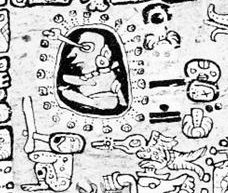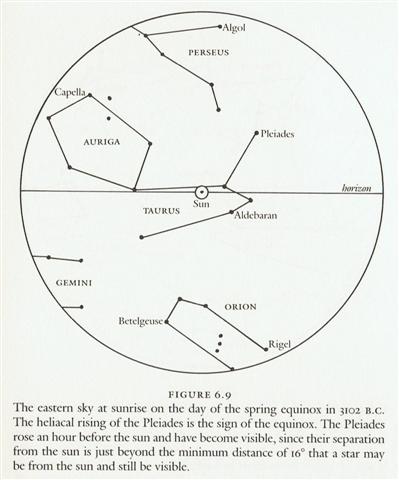Life emerges both on land in
'vegetable moulds' ('earth heaped up',
Ahu-one) and on the reefs where land and
sea are joining. I have written a group of more
additional (+) pages:
The stars which at a given date rose together with the Sun could not be observed. Any attempt to do so would have resulted in 'burnt eyes' (maka wela in the Hawaiian dialect of the Polynesian language):
... The eye is the symbolic site of subjection. Valeri observes that: 'The two sentiments that permit the transcendence of the self are, according to Hawaiians, desire and respect. One and the other are called kau ka maka, literally, 'to set one's eyes on' ...
'To see' (ike) in Hawaiian (as in French or English) is 'to understand', but it is also 'to know sexually'.
Witness to the order, the world of forms generated by the chief, the eye, is the sacrifice of those who violate that order. The left eye of the slain tabu-transgressors is swallowed by Kahoali'i, ceremonial double of the king and living god of his sacrificial rites.
Like the sun, chiefs of the highest tabus - those who are called 'gods', 'fire', 'heat', and 'raging blazes' - cannot be gazed directly upon without injury. The lowly commoner prostrates before them face to the ground, the position assumed by victims on the platforms of human sacrifice. Such a one is called makawela, 'burnt eyes'.
So the astronomer instead sat down in the nights reaching out with his eyes for the less powerful 'fires':

Indirectly the position of the Sun could be deduced from looking at the face of the Full Moon, because the stars in her background would be diametrically opposite to the stars in the vicinity of Sun.
... In ancient times the priest-astronomers (Brahmans) determined the recurrence of the solstices and equinoxes by the use of the gnomon. Later they developed the Nakshatra system of star reference to determine the recurrence of the seasons, much as the Greeks used the heliacal rising of some star for the same purpose. An example of the operation of the Nakshatra system in antiquity can be seen in figure 6.9

Therefore I have in my tables with black text presented the nightside (nakshatra) stars half a year away from the heliacal (in blue) stars. The row immediately below the top row in my tables contains the dates (in rongorongo times) when the nakshatra (black) stars rose heliacally and these dates are half a year later than the heliacal ones:
| March 21 |
22 (81) |
23 |
24 |
21 |
| September 20 |
21 (264) |
equinox |
23 |
| no glyph |
 |
 |
 |
| Ca1-1 |
Ca1-2 |
Ca1-3 |
| koia |
ki te hoea |
ki te henua |
| Al Fargh al Thāni-25 |
ε Phoenicis (0.8) |
Uttara Bhādrapadā-27 / Wall-14 |
θ Andromedae (2.7), ζ Tucanae (3.5) |
| 0h (365.25) |
ALGENIB PEGASI (1.8), χ Pegasi (2.1) |
| Caph, SIRRAH (0.5) |
| 1842 A.D. |
1771 A.D. |
1700 A.D. |
1629 A.D. |
| 12h (182.6) |
Minkar (183.7), ρ Centauri (183.9) |
Hasta-13 / Chariot-28 |
Zaniah (185.8), Chang Sha (186.3) |
| Alchita, Ma Wei (183.1) |
Pálida (184.6), Megrez (184.9), GIENAH (185.1), ε Muscae (185.2) |
| 'Sea' |
| April 15 |
16 |
17 (107) |
365 |
| October 15 |
16 |
17 (290) |
 |
 |
 |
| Ca1-25 |
Ca1-26 |
Ca2-1 (27) |
| kiore ki te huaga |
kua moe ki te tai. |
Te heke |
| no star listed |
POLARIS, Baten Kaitos (26.6), Metallah (26.9) |
Al Sharatain-1 / Ashvini-1 / Bond-16 |
| Segin, Mesarthim, ψ Phoenicis (27.2), SHERATAN, φ Phoenicis (27.4) |
| 67 A.D. |
5 B.C. |
76 B.C. |
| τ Bootis (208.3), Benetnash (208.5) |
ν Centauri (208.7), μ Centauri, υ Bootis (208.8) |
Muphrid (210.1), ζ Centauri (210.3 |
| 'Sea' |
'Land' |
I have above adjusted down the dates for 'the First Point of Aries' (the March equinox) with 0.4 * 71 = 28 years as I suggested earlier.
In glyph line Ca3 we can find the heliacal stars which ruled the 2nd Arab manzil Al Dabarān:
| 0 |
- |
Zero |
η Andromedae |
11.4 |
April 1 (91) |
- |
0 |
| 1 |
Al Sharatain |
Pair of Signs |
β Arietis (Sheratan), γ (Mesarthim) |
27.4 |
April 17 (107) |
16 |
16 |
| |
|
Musca Borealis |
35 (Head of the Fly), 39 (Kaffaljidhma), and 41 Arietis (Bharani) |
41.4 |
May 1 (121) |
14 |
30 |
| 2 |
Al Dabarān |
Follower |
α Tauri (Aldebaran), θ¹, θ²´, γ (Hyadum I), δ (Hyadum II), ε (Ain) |
63.4 |
May 23 (143) |
22 |
52 |
Although the manzil name Al Dabarān closely resembles the star name Aldebaran I believe the Arabs used γ Tauri (Hyadum I) as their point of reference. Hyadum I formed a pair together with Hyadum II (δ)
I have above redmarked the stars which rose with the Sun at positions which (according to my star list) had the fraction 0.4 in their right ascension values and none of the other stars listed at Al Dabarān had this characteristic.
|
From the 'grasping
hand' (ε,
Albali) of the towel of
Aquarius,

intent on swallowing
the star
μ, to
the returning Musca Borealis (in May
1) there were 41.4 + 365¼ - 314.8 =
ca 92 days:
|
19 |
Al Baldah |
City |
π Sagittarii (Al
Baldah) |
290.1 |
January 5 (370) |
41 |
279 |
|
20 |
Al Sa’d al
Dhabih |
Lucky One of the
Slaughterers |
α Capricorni
(Gredi),
β (Dabih) |
308.0 |
January 23 (388) |
18 |
297 |
|
21 |
Al Sa’d al
Bula' |
Good Fortune of the
Swallower |
ε Aquarii (Albali),
μ, ν |
314.8 |
January 30 (395) |
7 |
304 |
Should we,
however, instead count from
the swallowed mata
(μ),
then the distance becomes
41.4 + 365¼ - 316.0 = ca 91
days. The latter number
equals 7 * 13 and is more
attractive, especially
because the C text seems to
prefer January 31 before
January 29 (the
date after reducing the RA
value of Albali with the fraction
0.4):
|
182 |
October 16
(289) |
70 |
December 26
(360) |
35 |
January 31 |
58 |
|
April 16
(289 - 183 =
106) |
June 26 (360
- 183 = 177) |
August 1
(177 + 36 =
213 |
 |
 |
 |
|
Cb8-12 (183) |
Cb11-2 (254) |
Cb12-16
(290) |
|
Te ariki |
ki te
ariki - te
hokohuki |
e ariki
kua iri |
|
no star
listed |
ν Pavonis
(280.4), κ
Cor. Austr.
(280.9) |
μ Aquarii
(316.0) |
|
POLARIS,
Baten Kaitos
(26.6),
Metallah
(26.9) |
β
Monocerotis
(97.0) |
no star
listed |
|
183 |
107 |
|
348 (= 10 *
29 + 2 * 29) |
Possibly Metoro's
e ariki kua iri
means the Shadow of
a King is going up
as if fetched by the
Eagle.
|
Iri
1. To go
up; to
go in a
boat on
the sea
(the
surface
of which
gives
the
impression
of going
up from
the
coast):
he-eke
te
tagata
ki ruga
ki te
vaka,
he-iri
ki te
Hakakaiga,
the
men
boarded
the boat
and went
up to
Hakakainga.
2.
Ka-iri
ki puku
toiri ka
toiri.
Obscure
expression
of an
ancient
curse.
Vanaga.
Iri-are,
a
seaweed.
Vanaga. |
|








